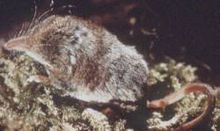Cinereus shrew
The cinereous shrew (Sorex cinereus) is a type of shrew. It is found in Alaska, Canada, and the northern United States. It is also called the masked shrew or the common shrew.[3]
| Cinereous shrew[1] | |
|---|---|

| |
| Scientific classification | |
| Domain: | Eukaryota |
| Kingdom: | Animalia |
| Phylum: | Chordata |
| Class: | Mammalia |
| Order: | Eulipotyphla |
| Family: | Soricidae |
| Genus: | Sorex |
| Species: | S. cinereus
|
| Binomial name | |
| Sorex cinereus Kerr, 1792
| |

| |
| Cinereus shrew range | |
Description
changeIt is grey-brown in colour. It light grey belly and a pointed snout. It has a long tail. Its body is about 9 cm in length including a 4 cm long tail. It weighs about 5 g. They can live up to two years.[4]
Distribution
changeIt lives in most of northern and southern North America to the Rocky Mountains in the west, and to the Appalachians in the east. This species was introduced into Newfoundland in the late 1950s. It can be found in many types of habitats like arid grasslands, places with lots of water, woodlands, and tundra. It mostly lives in humid places and with lots of plants to hide in.
Feeding
changeCinereus shrews eat insects, worms, snails, small rodents, salamanders, and seeds. They can only live for a few hours without food because of their high metabolism.
Predators
changePredators include larger shrews, hawks, owls, shrikes, snakes, herons, foxes, leopard frogs, bluebirds, brown trouts, and weasels.
Behavior
changeThe cinereus shrew can be diurnal or nocturnal depending on the weather. It digs tunnels but also uses tunnels made by other small mammals. It uses dry grass to make nests in these tunnels. It does not like other shrews to come into its territory.
Reproduction
changeCinereus shrews breed from May to September. Females give birth to 6 to 7 young ones. The young ones are born hairless and do not have claws. They become sexually mature at two months. But they wait until their first spring to breed.
References
change- ↑ Hutterer, Rainer (2005). Don E. Wilson; DeeAnn M. Reeder (eds.). Mammal Species of the World (3rd ed.). Johns Hopkins University Press. p. 286. ISBN 978-0-8018-8221-0.
- ↑ NatureServe (2008). "Sorex cinereus". IUCN Red List of Threatened Species. 2008. Retrieved 8 February 2010.
- ↑ Assessment), Francesca Cassola (Global Mammal (2016-08-18). "IUCN Red List of Threatened Species: Sorex cinereus". IUCN Red List of Threatened Species. Retrieved 2020-09-15.
- ↑ Yom-Tov, Yoram; Yom-Tov, Jonathan (2005). "Global warming, Bergmann's rule and body size in the masked shrew Sorex cinereus Kerr in Alaska". Journal of Animal Ecology. 74 (5): 803–808. doi:10.1111/j.1365-2656.2005.00976.x. ISSN 0021-8790.[permanent dead link]
